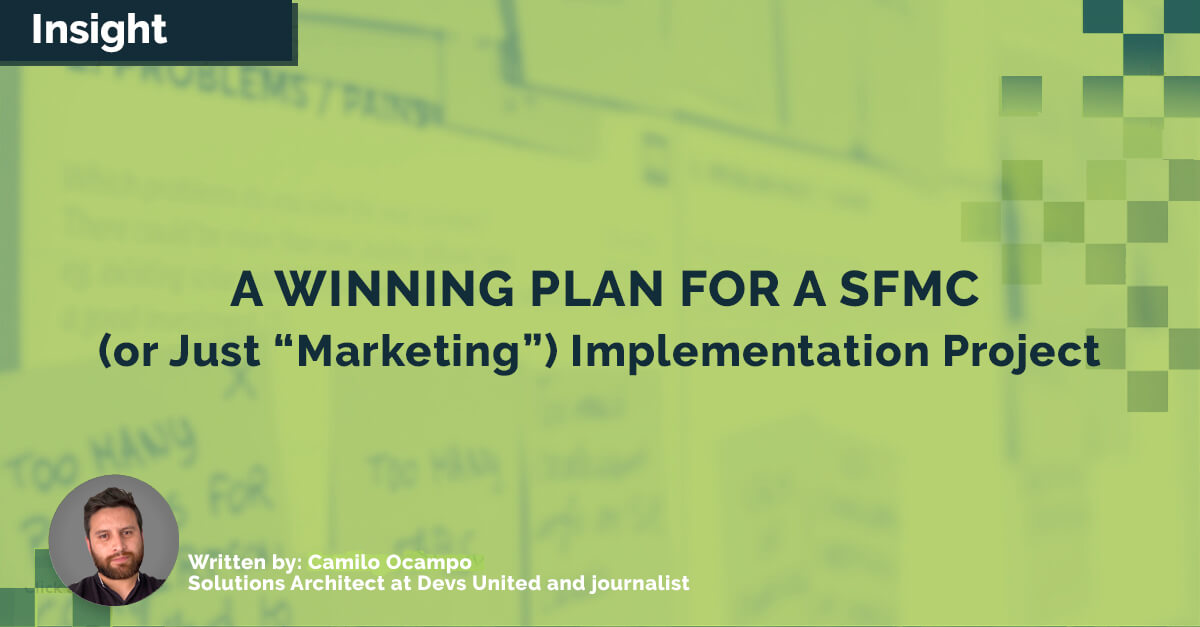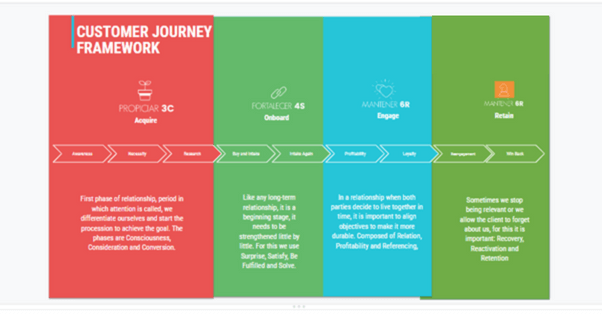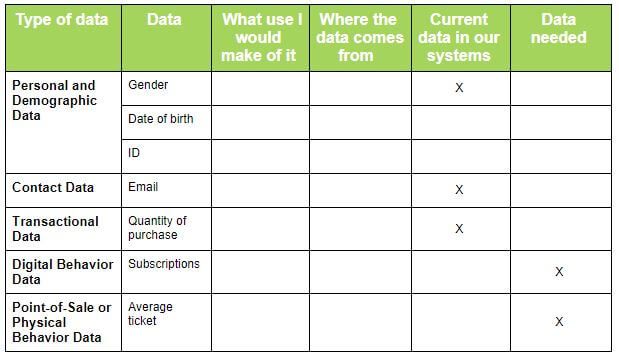
A Winning Plan for a Marketing Cloud (or Just “Marketing”) Implementation Project
Often, as marketers working with technology tools, we can become too reliant on technology, be too tactical, and get lost in the world of what and not how. The problem with this approach is that if you think too much about the technology you have available and not about your real goals and plans, you can move away from what your company needs from you. You are a marketing specialist who should be focusing on the pain points of your business, not a technical role that is expected to make the most of technology tools.
Although talking about marketing planning may involve a number of guides and expert advice, it is necessary to go back to basics and determine the strategy that will guide all our actions.
That is why we believe that before any technology or tool, it is important to plan. In the day-to-day this practice has been lost, and the chaos of everyday life does not allow us to think clearly about the actions we need to develop; therefore, we suggest a planning structure that has the following components:
- Describe Your Golden Circle of Value
- Define Your POV
- Determine Your Buyer Personas and Their Needs
- Think in the Customer Journey by Stages
- Data Model or Data Needs
- Objectives and KPIs
- Objectives per Quarter
- Actions or Tactics per Quarter (with pull and push strategy)
- Description of the Actions to Be Executed
- Testing and MVP
1. Describe Your Golden Circle of Value
Before defining your POV, it is common to use a powerful tool: the Circle Of Value. This is a concept that describes not only what you do, but what your purpose and identity are as well.
You can start by writing what you do, followed by how you do it (i.e., the particular way in which you deliver services or products), and finally the WHY – the main reason why you do what you do. Sometimes, this answer comes with an emotion, a nonquantitative value that better describes what you want to evoke in your customers. Do you want to evoke confidence and trust in your delivery service, like Amazon, or maybe have the right answer at the right time like Google does? Let’s focus on the results you want to have in your ideal customer with the help of your brand.
Note: The Circle of Value or Golden Circle is a concept created by Simon Sinek, a marketing leader and speaker who conveys how brands can inspire people if they start with their “Why.” Great organizations communicate inside out: first the why, then how you do it and what you do. Avoid simply telling your audience about your product and service; there is always much more to it.
2. Define Your POV
The promise of value consists of defining why our prospects are going to buy from us. Your POV explains how your product or service solves customers’ problems, delivers specific benefits, or tells the ideal customer why they should buy from you and not from the competition.
After writing your Circle of Value proposition or phrase, the POV is usually the combination of the What, How and Why.
3. Determine Your Buyer Personas and Their Needs
Normally, this step has already been covered by the companies; however, the daily execution of our work can make us forget our target audience, not only in demographic and data terms but also in what they want.
A very useful instrument to determine buyer personas is thinking about the following items:
- Who they are
- Their worries
- Principal challenges they face
- Their objectives
- Their barriers
- What your brand can do for them
- Verbatims (common phrases the buyer persona could use to express a need or feeling)
Don’t forget that your content verticals will follow the previous buyer persona definition. At the end of the day, the content is the tool to relieve the buyer persona’s needs.
4. Think in the Customer Journey by Stages
The overall experience of your customer can be developed in Marketing Cloud, but first, it needs to be designed so we can understand the stage of the buyer’s journey. This allows us to create specific emails, SMS, or mobile push notifications that will go in every stage.

5. Data Model or Data Needs
Yep, this is the part of the article where we start to talk about data. When the previous steps have been completed, the next task is to think about what information/data we currently have from our customers, and of course, what additional data we need from them. We call it a Data Strategy or Progressive Profiling approach. In this phase, we can use a spreadsheet to understand the information we want to use for personalization, and also the information we need to personalize to best engage with our customers. Data can also help us in segmentation and in the process of asking customers to complete their profiles in exchange for some benefits, such as discounts or trials.
To complete this task, we offer you two items; the first is the customer data sheet, in which you write down the data you have, the data you want and its possible use.

The second is simply a diagram that describes the sources of data we are expecting to have. This will help not only your marketing and data team but also your vendors, who are always attempting to understand how your business works in terms of data flow.

6. Objectives and KPIs
Before addressing the actions to develop in the plan, we need to figure out the main KPIs or metrics to follow, starting with the most important and their subsequent sub-metrics or objectives. This guide will help you properly define the metrics:

7. Objectives per Quarter
With the aim of navigating among the previous KPIs, it is important to determine specific objectives during the trimester or quarter, trying to adjust the general goals and tying them with achievable numbers during the year.
Of course, those objectives will be followed by marketing actions that will be discussed in the next component.
8. Actions or Tactics per Quarter
Once you have your KPIs and objectives divided by quarter, you can start by defining the marketing activities to complete. However, we will add some spice to it: Before just putting the names of the activities to follow and tying them to every objective and KPI, you need to divide those actions between pull and push actions.
PULL actions will be the activities to educate, inform and maybe entertain your customer. You’ll not always want to say “buy from me,” and that’s why pull actions include sending informational emails, blog entry updates or general branding initiatives – in other words, pull actions are what we call in marketing the “nurturing phase.”
On the other hand, PUSH actions are those initiatives that pursue the action from the customer, something like “request a quote,” “check out our 7-day trial” or “schedule a call with a salesperson.” Push actions are the moment of truth in the marketing plan when your customers are encouraged to take action after being “nurtured” about your services and products. Some marketers don’t do pull actions; they just overwhelm their clients or prospects with pushy messages without creating the right momentum.
As a wrap-up, your marketing actions need to be divided between pull and push, and you should alternate each one depending on the common sales cycle of your product or service. For example, if you offer golf classes, you just need a couple of pull actions before doing a push one; if you offer B2B services, the sales cycle is longer, and you will therefore need to do a lot of pull actions to try to reach the correct people inside a company.
9. Description of the Actions to Be Executed
The final step consists of describing your actions; for this phase, don’t forget to break down each action in terms of:
- Audience: The people to target in your communications
- Channels: You need to choose wisely; will it be email, SMS or mobile push?
- Message or content: Templates, social media posts, ads, etc.
- Data to use for personas and segments: What data do you have to segment your audience? What data will help you to personalize the message?
- Objective: Remember the KPIs and your quarterly goals. Each action needs to be tied to a specific objective.
- Journey mapping: This is the part where you design your customer experience, the number of communications, the desired behavior from your client, or maybe the reminders you need to send to encourage a certain action.
10. Testing and MVP
In marketing, we usually wait for the perfect action, the perfect strategy or campaign. Don´t do that!! The principle that governs every initiative is iteration: plan quickly, test, measure, adjust based on the results and test again.
Do you have any hypotheses regarding your audience or your message? Maybe it’s the pacing of your emails, the type of content, or just a subject that resonates better. Create the test, try different variables over the audiences, and define your takeaways. Don’t expect the best results from every action unless you took the time to understand the behavior of your customers.
Takeaway
You will hopefully find this guide useful for your next marketing strategy. It offers you an agnostic roadmap to follow, no matter the technology you are using; but, of course, if you are willing to use or currently using Salesforce Marketing Cloud, you will need the right partners to do it. Feel free to write to us and share your doubts or comments in regard to the whole Salesforce stack.

